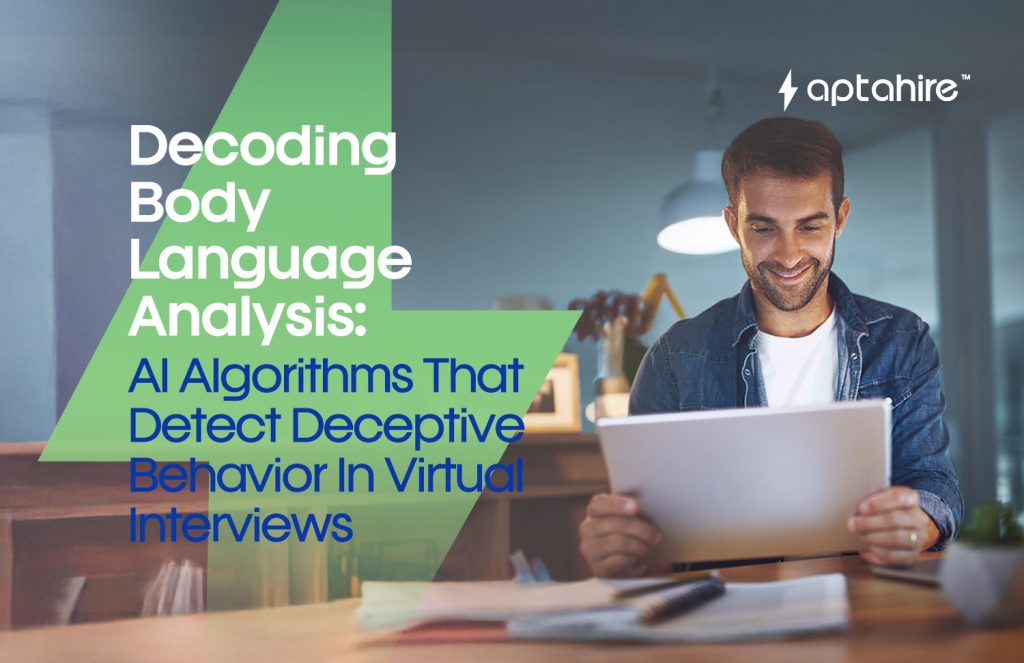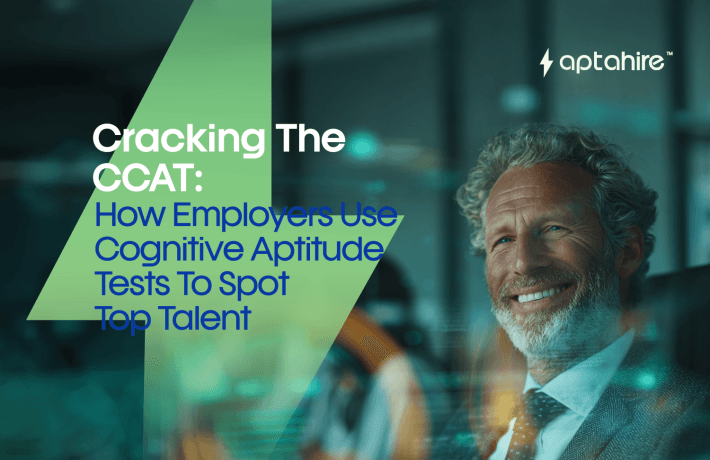Decoding Body Language Analysis: AI Algorithms That Detect Deceptive Behavior in Virtual Interviews

Introduction
A well-rehearsed resume. Polished answers. Smooth delivery. On paper, and on video, everything might seem perfect.
But what if there’s something more… something between the lines?
In face-to-face interviews, recruiters have long relied on body language to get a clearer picture of the candidate’s authenticity and confidence. From a nervous leg shake to a confident nod, these subtle, nonverbal cues often speak louder than a well-constructed answer.
In the virtual world, however, those cues are harder to catch. A pixelated screen, bad lighting, or just a limited frame can filter out valuable insights.
Enter: AI-powered body language analysis, an intelligent layer that doesn’t just watch candidates but understands them. This is the new frontier of virtual hiring: where algorithms observe microexpressions, posture shifts, and gestures to detect possible deceptive behavior.
Why Body Language Is Crucial in Virtual Interviews
Your body communicates more than your words. Research suggests 55% of communication is nonverbal, tone and actual words account for only 38% and 7%, respectively. In hiring, that 55% can be the difference between hiring the right person… or a rehearsed pretender.
Here’s what body language typically reveals in interviews:
- Confidence: Direct gaze, upright posture, steady gestures
- Uncertainty or stress: Fidgeting, lip biting, blinking rapidly
- Dishonesty: Mismatched expressions, face-touching, gaze aversion
- Engagement: Nodding, leaning in, facial mirroring
But when interviews go remote, much of this becomes muted or lost in translation. Recruiters are left with just a head-and-shoulders view and limited time.
That’s where AI steps in, to amplify human perception and bring science into virtual behavioral analysis.
How AI Decodes Body Language
To understand deceptive behavior, AI relies on a combination of computer vision, deep learning, and behavioral science. Let’s break it down:
Step 1: Real-Time Video Capture
AI captures live video of candidates during interviews (with consent). This feed becomes the raw data input. It doesn’t just look for broad movements, it watches for tiny microexpressions and posture shifts.
Step 2: Feature Detection Using Computer Vision
AI algorithms extract facial landmarks and skeletal points using pose estimation and facial mapping. For example:
- Facial landmarks: Eyes, brows, nose, mouth corners, jawline
- Body landmarks: Shoulder alignment, hand movement, torso posture
Using these, the system tracks:
- Eye contact and gaze patterns
- Blink rates
- Lip pursing, smirks, fake vs real smiles
- Shoulder movements (hunched = stress)
- Fidgeting or self-soothing gestures (like rubbing hands)
These raw signals are transformed into data points for behavioral modeling.
Step 3: Behavioral Modeling & Pattern Recognition
The real magic happens here. Advanced AI models analyze sequences of gestures, micro-movements, and expressions across time.
Key technologies involved:
- Convolutional Neural Networks (CNNs): For analyzing facial frames pixel-by-pixel
- Recurrent Neural Networks (RNNs) / LSTMs: For tracking time-based patterns — how a smile fades, how eyes shift, how gestures repeat
- Support Vector Machines (SVMs): For classifying behavioral categories (e.g., confident vs stressed)
Combined, these models detect behavior anomalies, such as a confident tone with deceptive facial cues, or too many unconscious movements during critical questions.
How AI Knows You’re Lying (Well, Sort Of…)
Let’s be clear: AI doesn’t “know” you’re lying. It identifies behavioral inconsistencies and patterns statistically associated with deceptive or evasive behavior.
For instance:
| Behavior | Possible Interpretation |
| Frequent face-touching | Anxiety or nervousness |
| Gaze aversion during tough questions | Discomfort, possibly evasion |
| Forced smile after answering | Masked emotion or dissonance |
| Sudden posture shift | Emotional response, discomfort |
| Repetitive gestures | Overcompensation or nervous energy |
These aren’t proof of dishonesty, but indicators. Human recruiters can use these insights to ask follow-up questions, probe deeper, or rewatch flagged segments.
Deep Dive: The AI Models Behind the Magic
1. CNNs (Convolutional Neural Networks)
Used primarily for image analysis. CNNs detect muscle shifts in the face, gesture outlines, and posture alignment frame-by-frame.
2. RNNs and LSTMs (Recurrent Neural Networks)
These time-aware models detect behavior that changes over seconds or minutes. For example, blinking too fast for 15 seconds when asked about salary expectations.
3. Pose Estimation Models
These estimate joint positions to detect slouching, leaning in, or nervous hand movements.
4. Emotion Recognition Models
Pre-trained models like OpenFace or Affectiva are used to detect emotions: joy, fear, anger, sadness, and their intensity based on facial cues.
5. Anomaly Detection Algorithms
Unsupervised learning models that flag unusual behavior patterns based on past data, helpful in catching something “off” without knowing exactly what.
Real-World Applications in Hiring
Candidate Authenticity Verification
Is the candidate truly passionate or pretending? AI picks up on microemotional mismatches that could reveal disinterest or discomfort.
Behavioral Interviewing Support
If AI detects a sudden spike in stress during certain competency questions, recruiters can revisit or rephrase them.
Remote Hiring at Scale
AI can help analyze hundreds of virtual interviews, offering summaries with behavioral heatmaps, saving recruiters hours.
Training Interviewers
It’s not just about catching liars, AI also helps recruiters learn how to ask questions that evoke honest responses.
Risks and Ethical Considerations
False Positives
Nervousness ≠ lying. Cultural norms, camera anxiety, or even poor Wi-Fi can skew behavior. This is why AI should support human judgment, not replace it.
Transparency and Consent
Candidates must know when and how their video data is being analyzed. Ethical hiring begins with clear communication.
Bias Mitigation
If AI models are trained only on a narrow demographic (e.g., Western facial structures), they might misread other cultural expressions. Diverse datasets are crucial.
Data Privacy
Video data is highly sensitive. Strict encryption, storage compliance (like GDPR), and limited access are mandatory.
How Candidates Can Prepare for AI-Analyzed Interviews
- Be Natural, Not Robotic – Authenticity is your best bet.
- Use a Stable Camera Setup – Good lighting and framing help AI see you better.
- Avoid Over-Gesturing or Overcompensating – Let your natural body language flow.
- Relax and Breathe – Calm nerves = steady, confident nonverbal behavior.
- Practice With a Mirror or Recording – Watch your own expressions to better understand them.
The Future of AI in Behavioral Hiring
Imagine a world where:
- AI can detect not just lies but empathy, leadership energy, and curiosity
- Behavioral insights are integrated into onboarding and team fit
- AI flags both red flags and green lights, celebrating candidates who exude honesty and passion
With time, AI won’t just detect deception, it’ll help us hire with more empathy and fairness, removing human error and unconscious bias.
Conclusion
AI-powered body language analysis adds a new lens to virtual hiring, one that watches not just what you say, but how you say it. From decoding micro-tells to empowering recruiters with deeper insights, it’s helping companies hire smarter, faster, and more fairly.
But it’s not about replacing humans with machines. It’s about giving humans a smarter pair of glasses to see what they might’ve missed, especially when the truth is hidden not in words, but in a fleeting glance, a nervous shift, or a genuine smile.
The future of hiring doesn’t just listen to your story.
It reads between the lines.
FAQs
1. Can AI actually tell if someone is lying?
Not directly. AI flags behavioral inconsistencies (like stress or avoidance), which may indicate deception but don’t prove it. It supports human decision-making.
2. What kind of body language does AI track?
Facial expressions, eye movement, blinking, hand gestures, posture, and microexpressions, all captured through computer vision and analyzed over time.
3. Will AI penalize candidates with anxiety or neurodivergence?
This is a valid concern. Ethical models are trained to reduce bias and must be combined with recruiter empathy and flexibility.
4. Is my video interview data stored permanently?
No, responsible platforms store data temporarily and securely, often anonymized, and only with candidate consent.
5. How accurate is AI in reading body language?
Accuracy depends on video quality, model training, and cultural diversity in data. When used correctly, it can enhance insights but not replace human judgment.
6. Can I train myself to beat the AI system?
You can improve your comfort and clarity, but deceptive behavior often shows in unconscious microexpressions, which are very hard to fake.
7. Will every company use this technology in the future?
As remote hiring grows, more companies are adopting behavioral AI tools, but ethical concerns and privacy laws will influence how widely it’s used.



